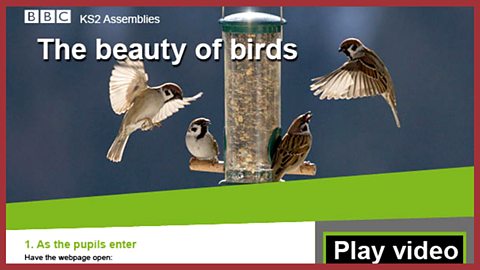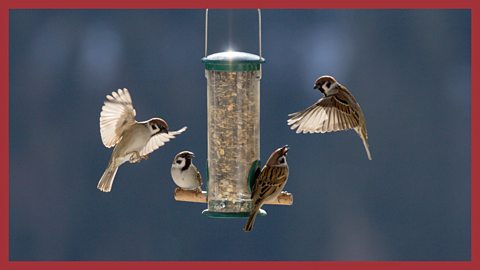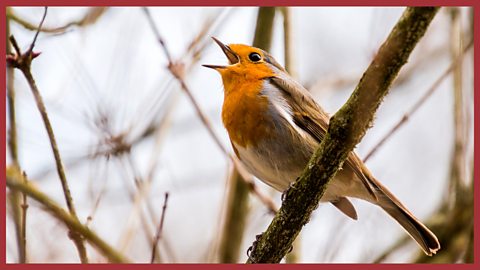In short...
Themes: ; ; nature; the wonder of creation; looking after birds and our world in general.
Summary: This assembly prompts children to pause and reflect on the beauty of birds and the wonders of nature. It can be linked to either the (Jan - Feb) or (first Sunday in May). It is a reminder of the life-enhancing role birds play in our world - such a familiar part of our everyday lives that they are often overlooked. It is also suitable for autumn and winter, when garden birds most benefit from humans leaving out food for them.
Resources: The . The assembly also includes an image of and a recording of the dawn chorus.

The video
Pupils Sonia and Lamek find out how to help birds and provide a suitable habitat for them in their school grounds.
They visit the , part of the Wildfowl and Wetlands Trust (WWT), where they observe birds from a hide and find out about the correct food for ducks.
Back at school, the children are joined by a member of the (RSPB) to make fat-balls and place them on a bird-table in the school grounds.
Soon, Sonia and Lamek see birds fly into school for a meal.
Duration: 5' 07"
End of speech: 'And it's great fun too!'
Video questions
- How can we attract birds to our school? (By providing the right conditions for them - bird-feeders, water and the right sort of food)
- What is a 'habitat' and what makes a good habitat for birds? (A habitat is a place to live. A good habitat for birds is an area with trees or bushes)
- Should we try to stroke birds? (No - they'll be scared by that)
- Is it ok to feed birds bread? What can happen if we feed bread to ducks? (RSPB advice is that it is ok to feed birds a small amount of bread in our gardens, as part of a varied diet. See this . However, the same advice does not apply to wildfowl in the open, where feeding bread has an environmental impact as well as being harmful to the animals)
- What is a hide? (An unobtrusive building from which birds can be watched without attracting their attention)

Key links
Download / print the assembly framework ready for use

Click to display the image full-size

Entry music - the dawn chorus. audio
Click to go to the ±«Óătv Earth recording of the dawn chorus


Suggested framework
1. Entry music
Play some dawn chorus bird song while the children enter (see Key links).
2. Introduction
Ask 'Does anyone know what the dawn chorus is?â Gather the childrenâs responses and guide them to the idea that the dawn chorus happens every day, starting before sunrise, and is loudest in May and June. You might say something like: âWhen the sun comes up, birds wake up and sing together. Most of us never hear the dawn chorus because weâre still asleep in our beds.'
Make the link between the dawn chorus and the Big Garden / Schools Birdwatch or International Dawn Chorus Day as appropriate, including for the latter that 'People around the world wake up early, so they can listen to the wonderful singing of the birds.â
You could add: âIn cold weather, it can be hard for birds to find food and water. The chemicals we often use in our gardens and on our farms can kill the insects many birds feed on. And when we cut down trees to make space for buildings and roads, birds lose places to nest and to live. Some kinds of bird we see every day in our parks and gardens are beginning to disappear. How can we help our birds?â
3. The video
Play the video. The duration is 5â 07â and the final words are: âAnd itâs great fun too!â
4. After the video
Ask the children to think of places they have seen bird-feeders. You could ask âWhere is the nearest bird-feeder to our assembly hall?â Perhaps a class in your school might be keen to put up or maintain bird-feeders in your school grounds?
5. Time to talk
Ask âWhat different birds can you name? What do those birds look like?â The children might respond by naming and describing birds such as robins, blackbirds, seagulls, pigeons, owls or magpies. As the children contribute, prompt them to reflect with questions such as: âWhatâs special about these birds?â, âWhy are birds important to us?â and âHow do birds make you feel?â The children might comment on the beauty of birds and on the sense of freedom they feel when they see birds in flight, for example.
You could ask one or two pupils to sketch their favourite bird as the assembly continues.
Another simple activity that helps capture a sense of wonder about birds is to write a whole-school poem called âBirdsâ. Ask the children to come up with two-word nicknames for birds, that all end in -er. Give them some examples: 'Cloud catcher', 'Feather ruffler', 'Storm rider', 'Seed nibbler', 'Sunrise singer'. List each suggestion from the pupils as a line in the poem and then together, read aloud the completed verse. Invite pupils to write their own bird poems at home if theyâd like to, or to sketch birds they see. They could bring their poems and pictures into school to contribute to a growing display in the assembly hall.
6. Opportunity to sing
An opportunity to sing your chosen song. Suggestions from ±«Óătv collections below.
7. Opportunity to reflect
Ask the pupils to sit quietly and picture birds they have seen. Prompt them to reflect:
Take a moment today to notice the wonderful birds around you. What do they bring to our lives? How could we help look after them?
8. Opportunity for prayer
Use your standard form of address ('Dear God', etc) and:
We thank you for the beautiful birds in our skies and our parks and our gardens.
Help us to notice them, to wonder at their beauty and never to take it for granted.
Help us to do what we can to take care of the natural world.
Amen.

Suggested songs
Song: 'All things bright and beautiful' (Come and Praise, no 3. Vocal version)
All things bright and beautiful,
All creatures great and small,
All things wise and wonderful,
The Lord God made them all.
Each little flowâr that opens,
Each little bird that sings,
He made their glowing colours,
He made their tiny wings:
Chorus
The purple-headed mountain,
The river running by,
The sunset and the morning,
That brightens up the sky:
Chorus
The cold wind in the winter,
The pleasant summer sun,
The ripe fruits in the garden,
He made them everyone:
Chorus
He gave us eyes to see them,
And lips that we might tell
How great is God Almighty
Who has made all things well:
Chorus
Song: 'He's got the whole world' (Come and Praise, no 19. Vocal version)
Heâs got the whole world, in His hand,
Heâs got the whole wide world, in His hand,
Heâs got the whole world, in His hand,
Heâs got the whole world, in His hand.
Heâs got the wind and the rain, in His hand,
Heâs got the wind and the rain, in His hand,
Heâs got the wind and the rain, in His hand,
Heâs got the whole world in His hand.
Chorus
Heâs got the sun and the moon, in His hand,
Heâs got the sun and the moon, in His hand,
Heâs got the sun and the moon, in His hand,
Heâs got the whole world in His hand.
Chorus
Heâs got the plants and the creatures, in His hand,
Heâs got the plants and the creatures, in His hand,
Heâs got the plants and the creatures, in His hand,
Heâs got the whole world in His hand.
Chorus
Heâs got everybody here, in His hand,
Heâs got everybody here, in His hand,
Heâs got everybody here, in His hand,
Heâs got the whole world in His hand.
Chorus

Related links
